Target Information
| Target General Information | Top | |||||
|---|---|---|---|---|---|---|
| Target ID |
T31621
(Former ID: TTDR00567)
|
|||||
| Target Name |
Fibroblast growth factor-2 (FGF2)
|
|||||
| Synonyms |
bFGF; Heparin-binding growth factor 2; HBGF-2; Fibroblast growth factor 2; FGFB; FGF-2; Basic fibroblast growth factor
Click to Show/Hide
|
|||||
| Gene Name |
FGF2
|
|||||
| Target Type |
Successful target
|
[1] | ||||
| Disease | [+] 1 Target-related Diseases | + | ||||
| 1 | Acne vulgaris [ICD-11: ED80] | |||||
| Function |
Acts as a ligand for FGFR1, FGFR2, FGFR3 and FGFR4. Also acts as an integrin ligand which is required for FGF2 signaling. Binds to integrin ITGAV:ITGB3. Plays an important role in the regulation of cell survival, cell division, cell differentiation and cell migration. Functions as a potent mitogen in vitro. Can induce angiogenesis.
Click to Show/Hide
|
|||||
| BioChemical Class |
Growth factor
|
|||||
| UniProt ID | ||||||
| Sequence |
MVGVGGGDVEDVTPRPGGCQISGRGARGCNGIPGAAAWEAALPRRRPRRHPSVNPRSRAA
GSPRTRGRRTEERPSGSRLGDRGRGRALPGGRLGGRGRGRAPERVGGRGRGRGTAAPRAA PAARGSRPGPAGTMAAGSITTLPALPEDGGSGAFPPGHFKDPKRLYCKNGGFFLRIHPDG RVDGVREKSDPHIKLQLQAEERGVVSIKGVCANRYLAMKEDGRLLASKCVTDECFFFERL ESNNYNTYRSRKYTSWYVALKRTGQYKLGSKTGPGQKAILFLPMSAKS Click to Show/Hide
|
|||||
| 3D Structure | Click to Show 3D Structure of This Target | AlphaFold | ||||
| ADReCS ID | BADD_A01487 | |||||
| HIT2.0 ID | T88QQE | |||||
| Drugs and Modes of Action | Top | |||||
|---|---|---|---|---|---|---|
| Approved Drug(s) | [+] 1 Approved Drugs | + | ||||
| 1 | Sucralfate | Drug Info | Approved | Acne vulgaris | [2], [3], [4] | |
| Clinical Trial Drug(s) | [+] 4 Clinical Trial Drugs | + | ||||
| 1 | Squalamine | Drug Info | Phase 3 | Solid tumour/cancer | [5] | |
| 2 | Bemarituzumab | Drug Info | Phase 2 | Gastric adenocarcinoma | [6] | |
| 3 | DVC1-0101 | Drug Info | Phase 2 | Arteriosclerosis | [7] | |
| 4 | FPA144 | Drug Info | Phase 1 | Bladder cancer | [8] | |
| Discontinued Drug(s) | [+] 2 Discontinued Drugs | + | ||||
| 1 | TGP-580 | Drug Info | Discontinued in Phase 2 | Neurodegenerative disorder | [9] | |
| 2 | RG-8803 | Drug Info | Terminated | Diabetic retinopathy | [10] | |
| Mode of Action | [+] 3 Modes of Action | + | ||||
| Modulator | [+] 4 Modulator drugs | + | ||||
| 1 | Sucralfate | Drug Info | [1], [3] | |||
| 2 | Squalamine | Drug Info | [11] | |||
| 3 | DVC1-0101 | Drug Info | [7] | |||
| 4 | TGP-580 | Drug Info | [13] | |||
| Antagonist | [+] 2 Antagonist drugs | + | ||||
| 1 | Bemarituzumab | Drug Info | [12] | |||
| 2 | FPA144 | Drug Info | [8] | |||
| Inhibitor | [+] 5 Inhibitor drugs | + | ||||
| 1 | RG-8803 | Drug Info | [14] | |||
| 2 | 1,4-Dideoxy-O2-Sulfo-Glucuronic Acid | Drug Info | [15] | |||
| 3 | 2-Sulfhydryl-Ethanol | Drug Info | [15] | |||
| 4 | BIBF100 | Drug Info | [16] | |||
| 5 | N,O6-Disulfo-Glucosamine | Drug Info | [15] | |||
| Cell-based Target Expression Variations | Top | |||||
|---|---|---|---|---|---|---|
| Cell-based Target Expression Variations | ||||||
| Drug Binding Sites of Target | Top | |||||
|---|---|---|---|---|---|---|
| Ligand Name: D-myo-inositol 1,4,5-trisphosphate | Ligand Info | |||||
| Structure Description | PI(4,5)P2 lipid binding induced a reorientation of FGF2 molecules near membrane surface to facilitate the unconventional oligomerization-dependent secretion process as revealed by a combined FTIR/NMR/X-ray study | PDB:5X1O | ||||
| Method | X-ray diffraction | Resolution | 1.90 Å | Mutation | No | [17] |
| PDB Sequence |
KDPKRLYCKN
27 GGFFLRIHPD37 GRVDGVREKS47 DPHIKLQLQA57 EERGVVSIKG67 VCANRYLAMK 77 EDGRLLASKC87 VTDECFFFER97 LESNNYNTYR107 SRKYTSWYVA117 LKRTGQYKLG 127 SKTGPGQKAI137 LFLPMSA
|
|||||
|
|
||||||
| Click to View More Binding Site Information of This Target with Different Ligands | ||||||
| Different Human System Profiles of Target | Top |
|---|---|
|
Human Similarity Proteins
of target is determined by comparing the sequence similarity of all human proteins with the target based on BLAST. The similarity proteins for a target are defined as the proteins with E-value < 0.005 and outside the protein families of the target.
A target that has fewer human similarity proteins outside its family is commonly regarded to possess a greater capacity to avoid undesired interactions and thus increase the possibility of finding successful drugs
(Brief Bioinform, 21: 649-662, 2020).
Human Tissue Distribution
of target is determined from a proteomics study that quantified more than 12,000 genes across 32 normal human tissues. Tissue Specificity (TS) score was used to define the enrichment of target across tissues.
The distribution of targets among different tissues or organs need to be taken into consideration when assessing the target druggability, as it is generally accepted that the wider the target distribution, the greater the concern over potential adverse effects
(Nat Rev Drug Discov, 20: 64-81, 2021).
Human Pathway Affiliation
of target is determined by the life-essential pathways provided on KEGG database. The target-affiliated pathways were defined based on the following two criteria (a) the pathways of the studied target should be life-essential for both healthy individuals and patients, and (b) the studied target should occupy an upstream position in the pathways and therefore had the ability to regulate biological function.
Targets involved in a fewer pathways have greater likelihood to be successfully developed, while those associated with more human pathways increase the chance of undesirable interferences with other human processes
(Pharmacol Rev, 58: 259-279, 2006).
Biological Network Descriptors
of target is determined based on a human protein-protein interactions (PPI) network consisting of 9,309 proteins and 52,713 PPIs, which were with a high confidence score of ≥ 0.95 collected from STRING database.
The network properties of targets based on protein-protein interactions (PPIs) have been widely adopted for the assessment of target’s druggability. Proteins with high node degree tend to have a high impact on network function through multiple interactions, while proteins with high betweenness centrality are regarded to be central for communication in interaction networks and regulate the flow of signaling information
(Front Pharmacol, 9, 1245, 2018;
Curr Opin Struct Biol. 44:134-142, 2017).
Human Similarity Proteins
Human Tissue Distribution
Human Pathway Affiliation
Biological Network Descriptors
|
|
|
There is no similarity protein (E value < 0.005) for this target
|
|
Note:
If a protein has TS (tissue specficity) scores at least in one tissue >= 2.5, this protein is called tissue-enriched (including tissue-enriched-but-not-specific and tissue-specific). In the plots, the vertical lines are at thresholds 2.5 and 4.
|
| KEGG Pathway | Pathway ID | Affiliated Target | Pathway Map |
|---|---|---|---|
| MAPK signaling pathway | hsa04010 | Affiliated Target |
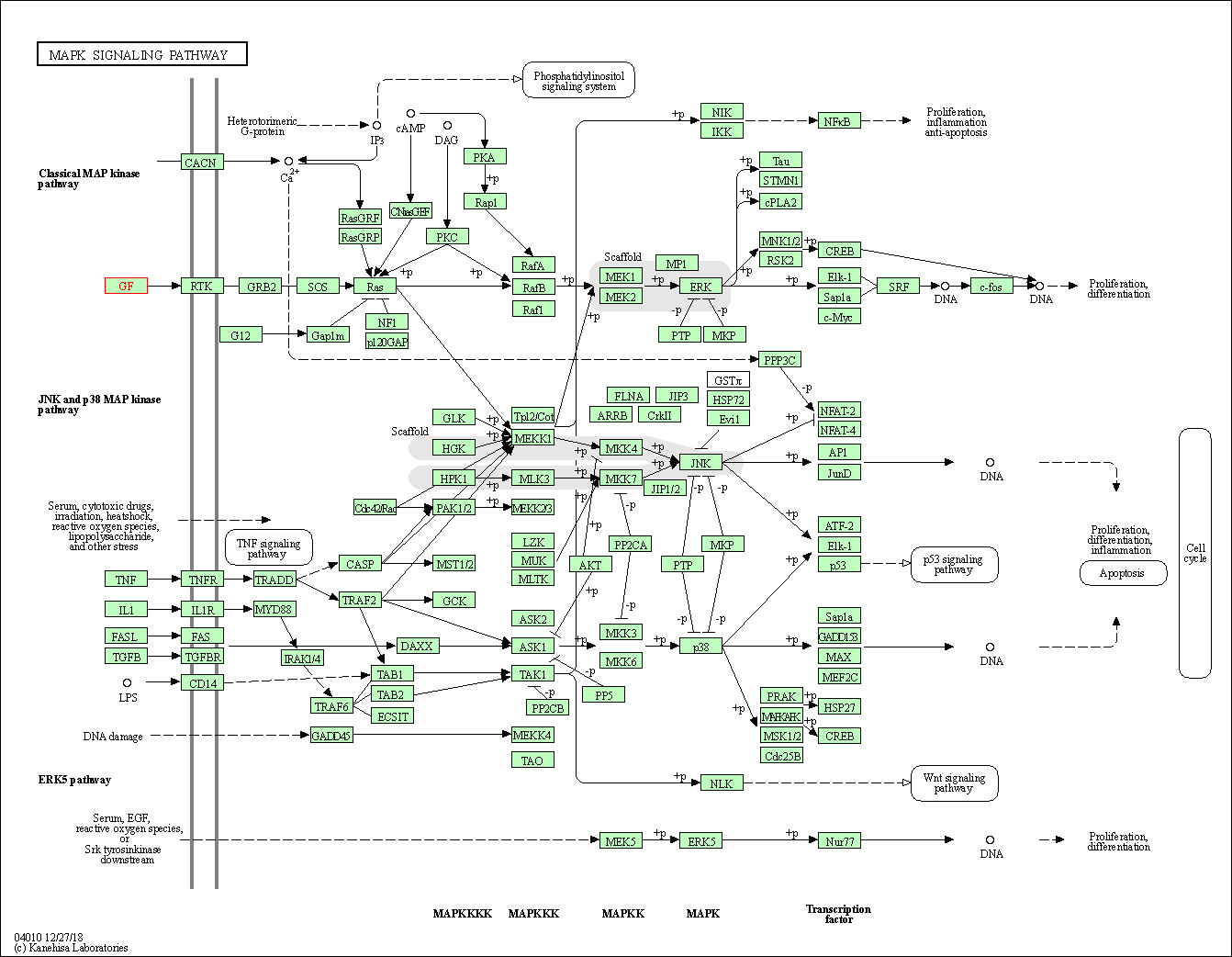
|
| Class: Environmental Information Processing => Signal transduction | Pathway Hierarchy | ||
| Ras signaling pathway | hsa04014 | Affiliated Target |

|
| Class: Environmental Information Processing => Signal transduction | Pathway Hierarchy | ||
| Rap1 signaling pathway | hsa04015 | Affiliated Target |
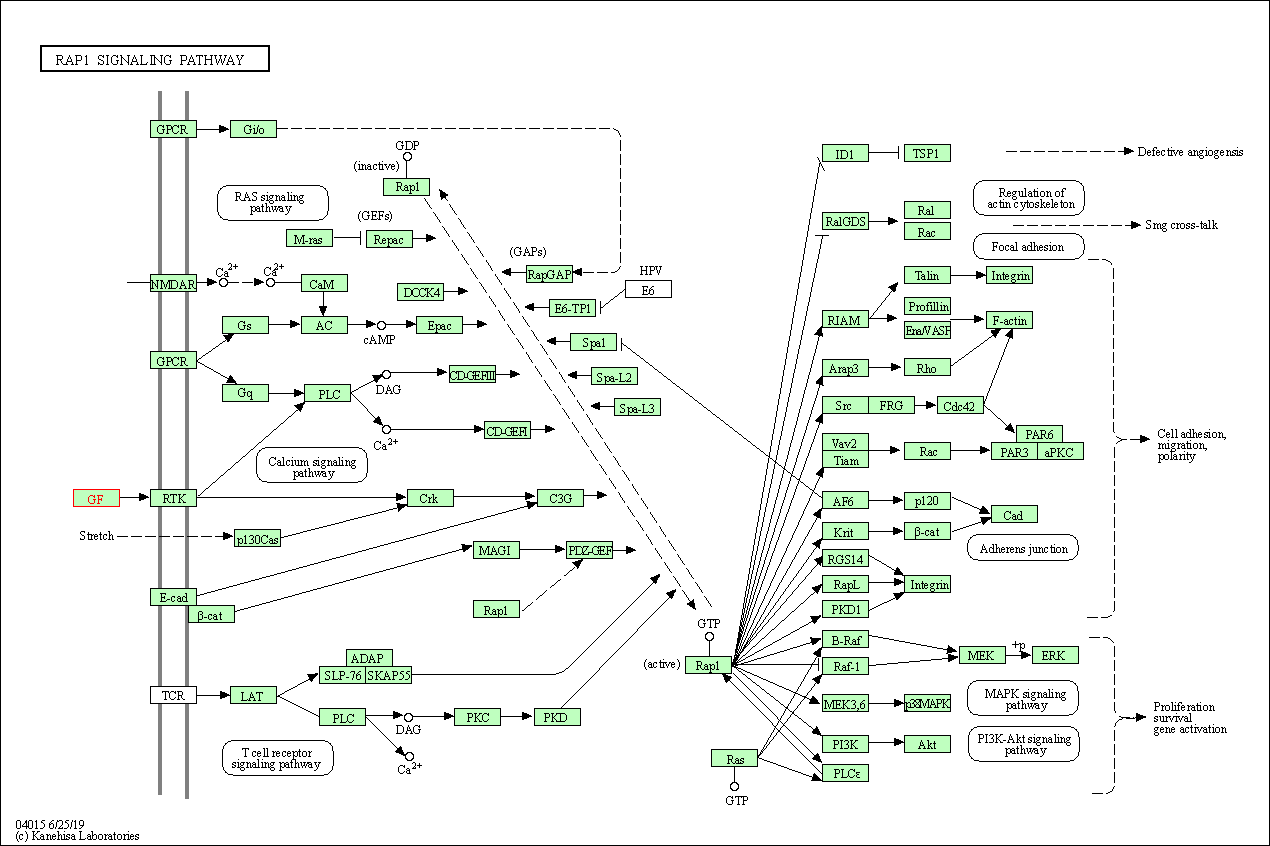
|
| Class: Environmental Information Processing => Signal transduction | Pathway Hierarchy | ||
| Calcium signaling pathway | hsa04020 | Affiliated Target |
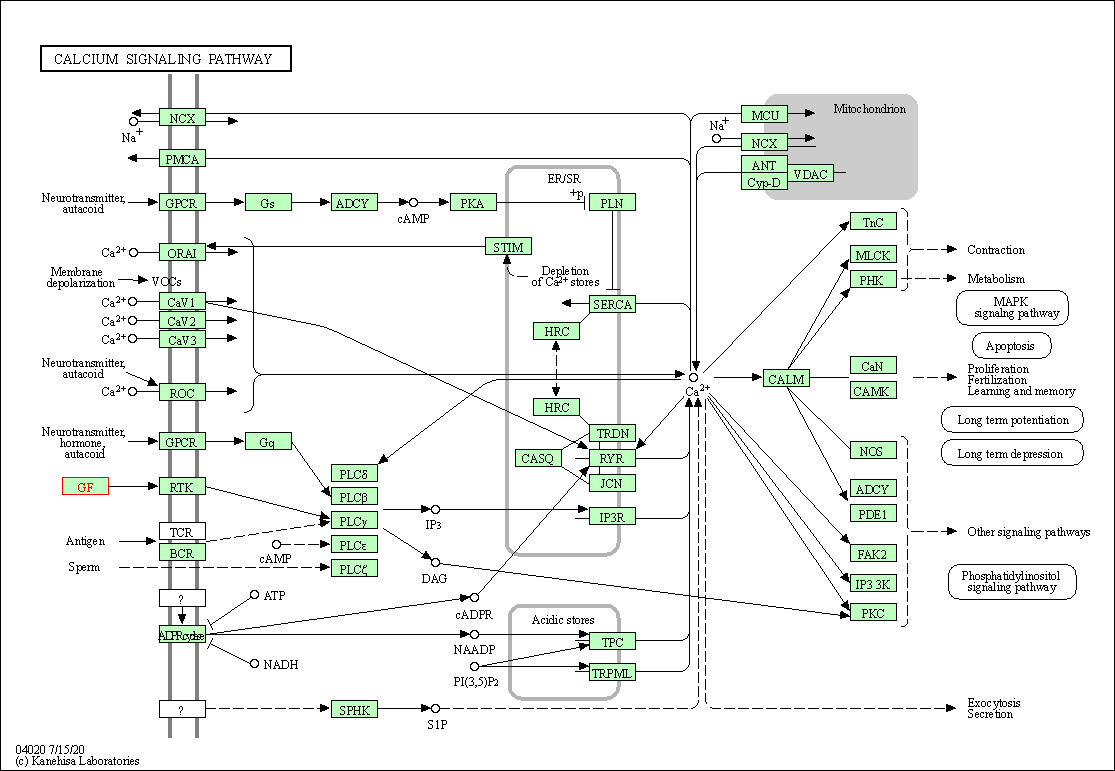
|
| Class: Environmental Information Processing => Signal transduction | Pathway Hierarchy | ||
| PI3K-Akt signaling pathway | hsa04151 | Affiliated Target |
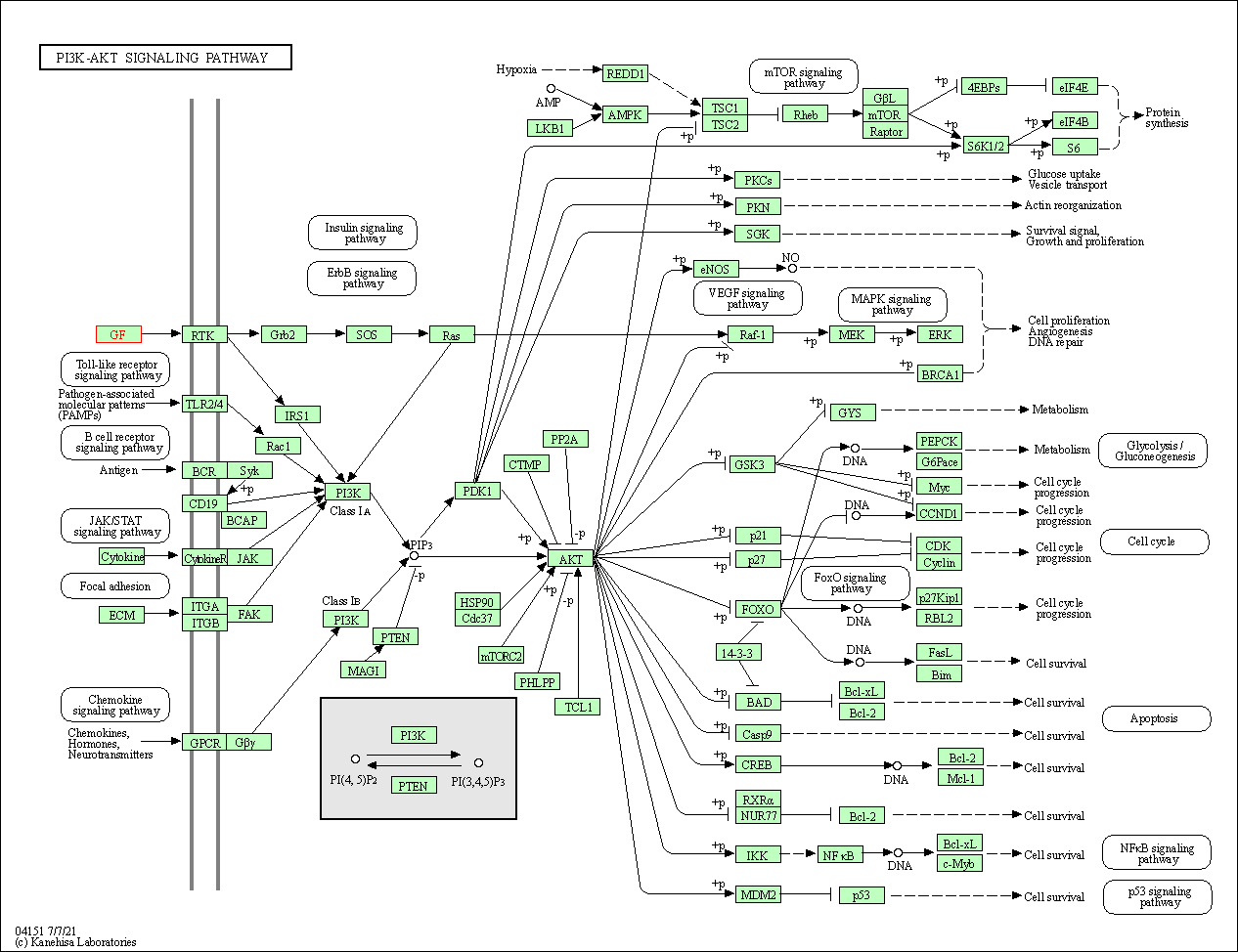
|
| Class: Environmental Information Processing => Signal transduction | Pathway Hierarchy | ||
| Signaling pathways regulating pluripotency of stem cells | hsa04550 | Affiliated Target |
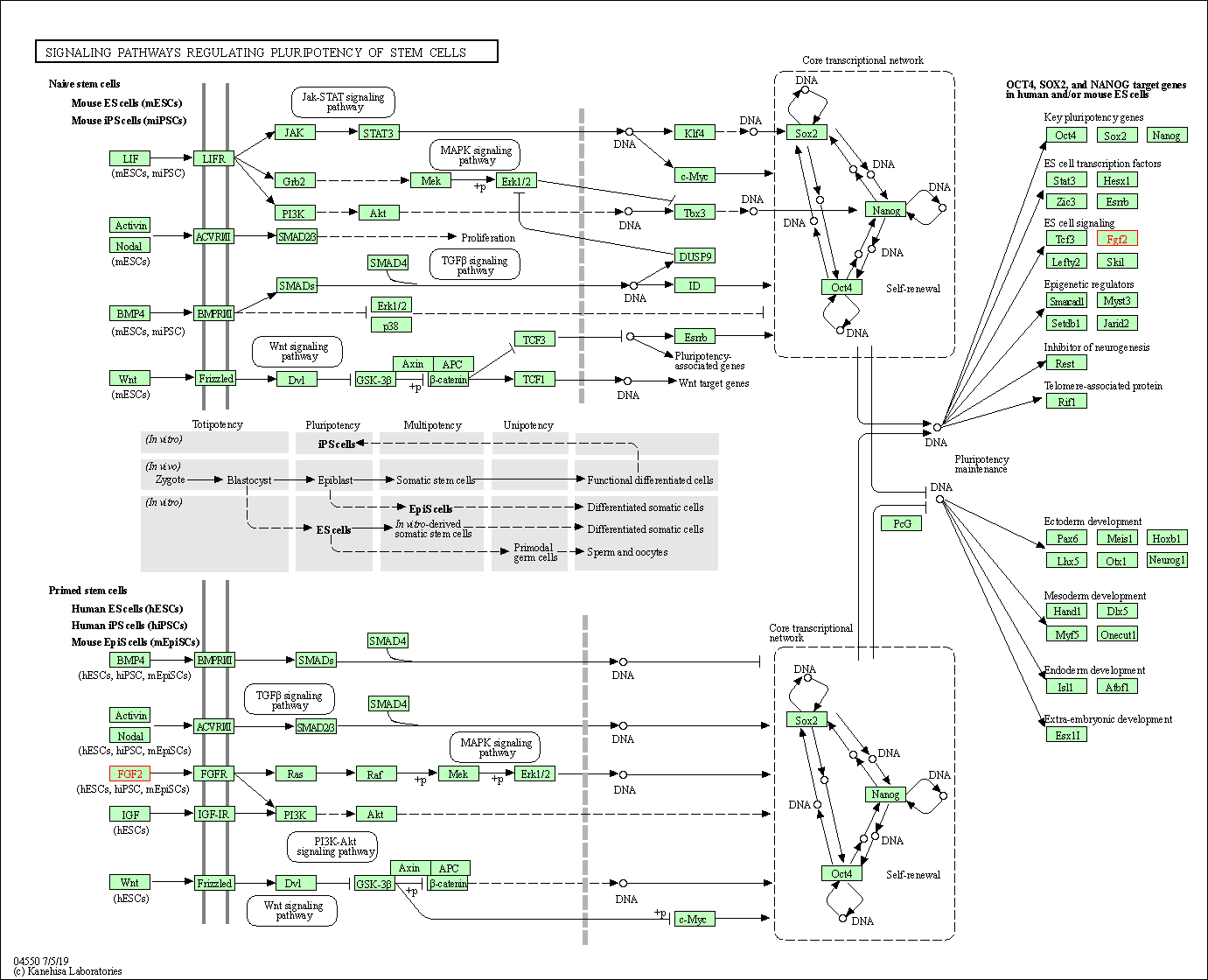
|
| Class: Cellular Processes => Cellular community - eukaryotes | Pathway Hierarchy | ||
| Regulation of actin cytoskeleton | hsa04810 | Affiliated Target |
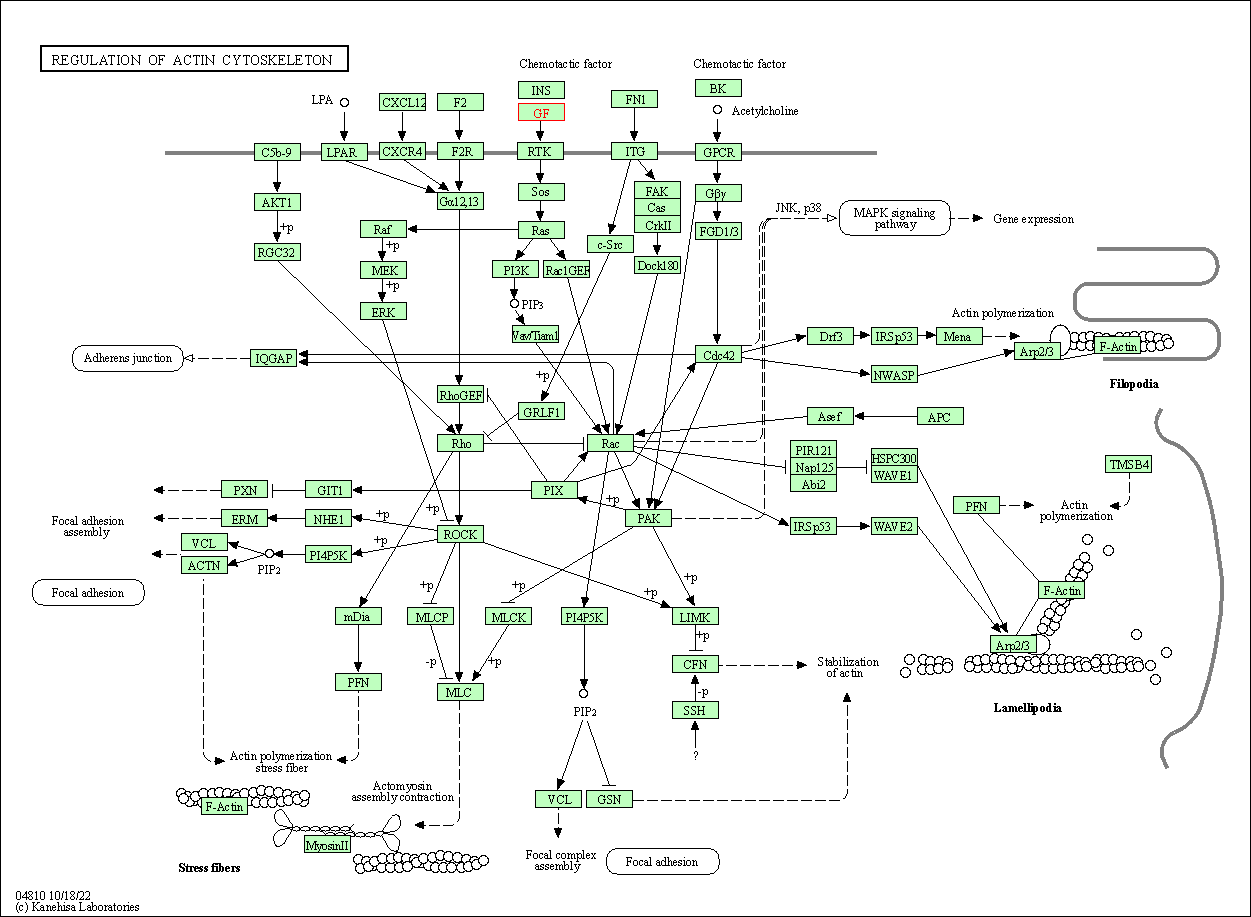
|
| Class: Cellular Processes => Cell motility | Pathway Hierarchy | ||
| Click to Show/Hide the Information of Affiliated Human Pathways | |||
| Degree | 39 | Degree centrality | 4.19E-03 | Betweenness centrality | 2.69E-03 |
|---|---|---|---|---|---|
| Closeness centrality | 2.44E-01 | Radiality | 1.43E+01 | Clustering coefficient | 1.39E-01 |
| Neighborhood connectivity | 3.15E+01 | Topological coefficient | 5.40E-02 | Eccentricity | 11 |
| Download | Click to Download the Full PPI Network of This Target | ||||
| Chemical Structure based Activity Landscape of Target | Top |
|---|---|
| Drug Property Profile of Target | Top | |
|---|---|---|
| (1) Molecular Weight (mw) based Drug Clustering | (2) Octanol/Water Partition Coefficient (xlogp) based Drug Clustering | |
|
|
||
| (3) Hydrogen Bond Donor Count (hbonddonor) based Drug Clustering | (4) Hydrogen Bond Acceptor Count (hbondacc) based Drug Clustering | |
|
|
||
| (5) Rotatable Bond Count (rotbonds) based Drug Clustering | (6) Topological Polar Surface Area (polararea) based Drug Clustering | |
|
|
||
| "RO5" indicates the cutoff set by lipinski's rule of five; "D123AB" colored in GREEN denotes the no violation of any cutoff in lipinski's rule of five; "D123AB" colored in PURPLE refers to the violation of only one cutoff in lipinski's rule of five; "D123AB" colored in BLACK represents the violation of more than one cutoffs in lipinski's rule of five | ||
| Target Poor or Non Binders | Top | |||||
|---|---|---|---|---|---|---|
| Target Poor or Non Binders | ||||||
| Target Regulators | Top | |||||
|---|---|---|---|---|---|---|
| Target-regulating microRNAs | ||||||
| Target-interacting Proteins | ||||||
| Target Profiles in Patients | Top | |||||
|---|---|---|---|---|---|---|
| Target Expression Profile (TEP) | ||||||
| References | Top | |||||
|---|---|---|---|---|---|---|
| REF 1 | Assessment of sucralfate coating by sequential scintigraphic imaging in radiation-induced esophageal lesions. Gastrointest Endosc. 1995 Feb;41(2):109-14. | |||||
| REF 2 | URL: http://www.guidetopharmacology.org Nucleic Acids Res. 2015 Oct 12. pii: gkv1037. The IUPHAR/BPS Guide to PHARMACOLOGY in 2016: towards curated quantitative interactions between 1300 protein targets and 6000 ligands. (Ligand id: 7055). | |||||
| REF 3 | Drugs@FDA. U.S. Food and Drug Administration. U.S. Department of Health & Human Services. 2015 | |||||
| REF 4 | ClinicalTrials.gov (NCT01284647) A Study to Evaluate the Efficacy of Teprenone On Chinese Patients With Chronic Non-Atrophic Erosive Gastritis. U.S. National Institutes of Health. | |||||
| REF 5 | ClinicalTrials.gov (NCT00139282) A Safety and Efficacy Study of Squalamine Lactate for Injection (MSI-1256F) for "Wet" Age-Related Macular Degeneration. U.S. National Institutes of Health. | |||||
| REF 6 | ClinicalTrials.gov (NCT03694522) A Study of Bemarituzumab (FPA144) Combined With Modified FOLFOX6 (mFOLFOX6) in Gastric/Gastroesophageal Junction Cancer (FIGHT) (FIGHT). U.S. National Institutes of Health. | |||||
| REF 7 | DVC1-0101 to treat peripheral arterial disease: a Phase I/IIa open-label dose-escalation clinical trial. Mol Ther. 2013 Mar;21(3):707-14. | |||||
| REF 8 | Clinical pipeline report, company report or official report of the Pharmaceutical Research and Manufacturers of America (PhRMA) | |||||
| REF 9 | Trusted, scientifically sound profiles of drug programs, clinical trials, safety reports, and company deals, written by scientists. Springer. 2015. Adis Insight (drug id 800001922) | |||||
| REF 10 | Trusted, scientifically sound profiles of drug programs, clinical trials, safety reports, and company deals, written by scientists. Springer. 2015. Adis Insight (drug id 800011158) | |||||
| REF 11 | Clinical pipeline report, company report or official report of Ohr Pharmaceutical. | |||||
| REF 12 | Clinical pipeline report, company report or official report of the Pharmaceutical Research and Manufacturers of America (PhRMA) | |||||
| REF 13 | Expression of fibroblast growth factor-2 transcripts in the healing of acetic acid-induced gastric ulcers. APMIS. 1999 Aug;107(8):767-72. | |||||
| REF 14 | US patent application no. 2010,0278,784, Methods and compositions for treating skin conditions. | |||||
| REF 15 | How many drug targets are there Nat Rev Drug Discov. 2006 Dec;5(12):993-6. | |||||
| REF 16 | Emerging therapies for multiple myeloma. Expert Opin Emerg Drugs. 2009 Mar;14(1):99-127. | |||||
| REF 17 | PI(4,5)P2 lipid binding induced a reorientation of FGF2 molecules near membrane surface to facilitate the unconventional oligomerization-dependent secretion process as revealed by a combined FTIR/NMR/X-ray study | |||||
If You Find Any Error in Data or Bug in Web Service, Please Kindly Report It to Dr. Zhou and Dr. Zhang.

